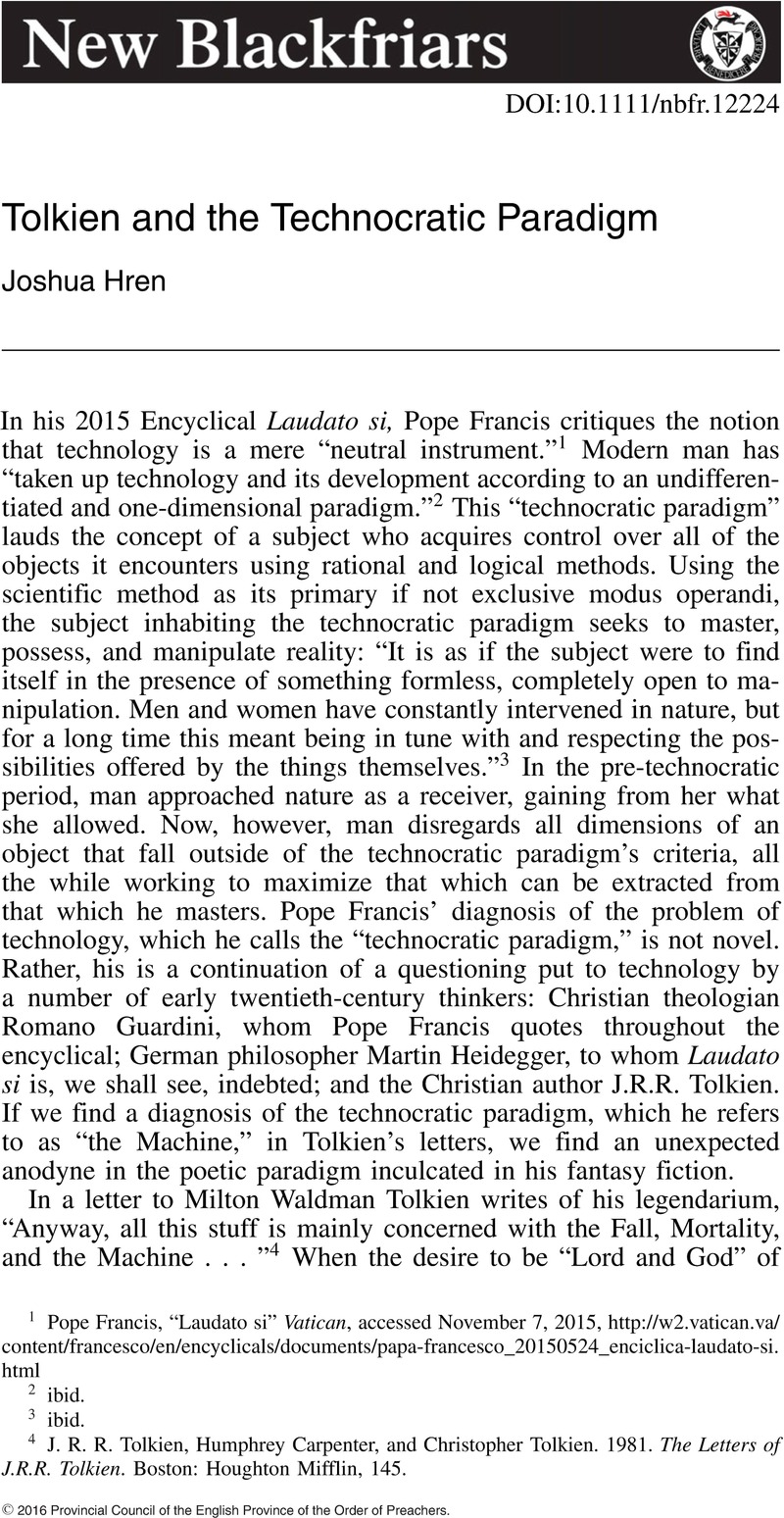Article contents
Tolkien and the Technocratic Paradigm
Published online by Cambridge University Press: 01 January 2024
Abstract

- Type
- Original Article
- Information
- Copyright
- Copyright © 2016 Provincial Council of the English Province of the Order of Preachers
References
1 Pope Francis, “Laudato si” Vatican, accessed November 7, 2015, http://w2.vatican.va/content/francesco/en/encyclicals/documents/papa‐francesco_20150524_enciclica‐laudato‐si.html
2 ibid.
3 ibid.
4 Tolkien, J. R. R., Carpenter, Humphrey, and Tolkien, Christopher. 1981. The Letters of J.R.R. Tolkien. Boston: Houghton Mifflin, 145Google Scholar.
5 Ibid, 146.
6 Guardini, Romano. 1998. The end of the modern world. Wilmington, Del: ISI Books, 56Google Scholar.
7 Heidegger, Martin. 1977. “The Question Concerning Technology.” The question concerning technology, and other essays. New York: Harper & RowGoogle Scholar.
8 ibid, 5.
9 Martin Heidegger stands at the center of that influential circle of persons who malign much of the philosophical theology of the West by considering it idolatrous syncretism of metaphysics and theology in which God's being and the impenetrable mysteries of his existence have been subjected to the philosophical‐scientific modes of analysis, and thereby de‐mystified and, ultimately, dangerously reduced. Tolkien's work is marked by lucid imprints of this very tradition of philosophical theology—be it the work of Plato, St. Augustine, or St. Thomas Aquinas.
10 Tolkien, Letters, 146.
11 Heidegger, “The Question Concerning Technology,” 12.
12 ibid, 13.
13 ibid, 14.
14 ibid, 15.
15 ibid, 15.
16 ibid, 16.
17 ibid, 16.
18 ibid, 19.
19 ibid, 27.
20 ibid.
21 Tolkien, J.R.R., 1994. The Lord of the Rings. New York: Houghton Mifflin Company, 1Google Scholar.
22 Ibid, 362‐363.
23 In his Preface to The Lord of the Rings, Tolkien addresses the decline of the old mill: “Recently I saw in a paper a picture of the last decrepitude of the once thriving corn‐mill beside its pool that long ago seemed to me so important. I never liked the looks of the Young miller, but his father, the Old miller, had a black beard, and he was not named Sandyman” (LOTR xxi).
24 Ibid, 1013.
25 Tolkien, Letters, 156.
26 Heidegger, “The Question Concerning Technology,” 19.
27 Pope Francis, Laudato si.
28 Tolkien, The Lord of the Rings, 1013.
29 Tolkien, Letters, 160.
30 It is also worth noting an intriguing connection between the Ring, the Machine, and Hegel's master‐slave dialectic. As Peter Kreeft polemicizes, modern man pines not for human slaves, because we have substitutes for them: machines. The Industrial Revolution made slavery inefficient and unnecessary. But our addiction is the same whether the slaves are made of flesh, metal, or plastic. We have done exactly what Sauron did in forging the Ring. We have put our power into things in order to increase our power. And the result is, as everyone knows but no one admits, that we are now weak little wimps, Shelob‘s slaves, unable to survive a blow to the great spider of our technological network. We tremble before a nationwide electrical blackout or a global computer virus. . . In our drive for power we have deceived ourselves into thinking that we have become more powerful when all the time we have been becoming less. We are miserable little Nietzsches dreaming we are supermen. For in gaining the world we have lost our selves. See Peter Kreeft, 2005. The Philosophy of Tolkien: The Worldview Behind The Lord of the Rings. San Francisco: Ignatius Press, 187‐188.
31 Tolkien, Letters, 279.
32 Tolkien, Letters, 279.
33 Pope Francis, Laudato si.
34 Tolkien, The Lord of the Rings, 267.
35 Tolkien, The Lord of the Rings, 267‐8.
36 Pope Francis, Laudato si.
37 Heidegger, “The Question Concerning Technology,”34.
38 Pope Francis, Laudato si.
39 Tolkien, Letters.
40 Tolkien, Letters, Ibid.
41 Tolkien, Letters, Ibid.
42 Tolkien, Letters, Ibid.
43 Heidegger, “The Question Concerning Technology,” 46.
44 Tolkien, Letters, Ibid.
45 Taylor, Charles, 2007. A Secular Age, Harvard: Harvard University Press, 278Google Scholar.
46 Ibid. 279.
47 Ibid., 287.
48 Ibid.
49 Tolkien, J.R.R., 2008. “On Fairy Stories,” Tales From the Perilous Realm, New York: Harper Collins, 373Google Scholar.
- 1
- Cited by




